Glass
Circa 1895-1910.
Heisey Glass was produced from 1896 to 1957 in Newark, Ohio, by A.H. Heisey & Co. The company was known for its high-quality glassware, often featuring intricate designs and a distinctive clarity.
To inquire about pricing and availability, please email BALL HILL The Arcade at info@ballhill.com.
Circa 1895-1910.
Heisey Glass was produced from 1896 to 1957 in Newark, Ohio, by A.H. Heisey & Co. The company was known for its high-quality glassware, often featuring intricate designs and a distinctive clarity.
To inquire about pricing and availability, please email BALL HILL The Arcade at info@ballhill.com.
Circa 1895-1910.
Heisey Glass was produced from 1896 to 1957 in Newark, Ohio, by A.H. Heisey & Co. The company was known for its high-quality glassware, often featuring intricate designs and a distinctive clarity.
To inquire about pricing and availability, please email BALL HILL The Arcade at info@ballhill.com.
Circa 1930's.
From the Collection of Michael Maher.
Heisey Glass was produced from 1896 to 1957 in Newark, Ohio, by A.H. Heisey & Co. The company was known for its high-quality glassware, often featuring intricate designs and a distinctive clarity.
To inquire about pricing and availability, please email BALL HILL The Arcade at info@ballhill.com.
Circa 1930’s.
From the Collection of Michael Maher.
Heisey Glass was produced from 1896 to 1957 in Newark, Ohio, by A.H. Heisey & Co. The company was known for its high-quality glassware, often featuring intricate designs and a distinctive clarity.
To inquire about pricing and availability, please email BALL HILL The Arcade at info@ballhill.com.
Circa 1930’s.
From the Collection of Michael Maher.
Heisey Glass was produced from 1896 to 1957 in Newark, Ohio, by A.H. Heisey & Co. The company was known for its high-quality glassware, often featuring intricate designs and a distinctive clarity.
To inquire about pricing and availability, please email BALL HILL The Arcade at info@ballhill.com.
Heisey Glass Company, founded in Newark, Ohio, in 1896, was known for producing high-quality, elegant glassware. Their Crystolite line, introduced in the early 20th century, was particularly popular for its clarity and intricate designs. Heisey pieces are often collected for their distinctive molds and the company's commitment to craftsmanship.
This particular leaf-shaped dish is a classic example of Heisey's Crystolite pattern, showcasing the delicate ribbing and clear glass that defined the line. These dishes were commonly used as nut dishes or small serving pieces, adding a touch of sophistication to any table setting. Heisey ceased production in 1957, making their pieces increasingly sought after by collectors.
To inquire about pricing and availability, please email BALL HILL The Arcade at info@ballhill.com.
The Heisey Glass Company, founded in 1896 in Newark, Ohio, was known for producing high-quality, elegant glassware. Their pieces were often characterized by their clarity, brilliance, and intricate designs. Heisey's 'Crystolite' pattern, introduced in the 1930s, is particularly recognizable for its clear, pressed glass with a distinctive ribbed or paneled design.
This pattern was popular for a variety of serving pieces, including relish trays, bowls, and platters. The company ceased production in 1957, making their glassware increasingly collectible. Pieces like this relish tray are sought after for their vintage charm and the quality craftsmanship that Heisey was known for.
To inquire about pricing and availability, please email BALL HILL The Arcade at info@ballhill.com.
Villeroy & Boch 'Quadra' Crystal Serving Bowl (Late 20th Century, West Germany)
Villeroy & Boch, founded in 1748, is a highly respected ceramics manufacturer known for its quality and design. The company has a long history of producing fine tableware, decorative items, and crystalware. Their designs often blend classic elegance with modern aesthetics.
The 'Quadra' line, produced in West Germany, is characterized by its geometric shapes and ribbed design, which gives it a distinctive and contemporary look. These pieces were popular during the late 20th century and are still sought after by collectors today. Villeroy & Boch crystal bowls are known for their clarity and craftsmanship, making them both functional and decorative.
To inquire about pricing and availability, please email BALL HILL The Arcade at info@ballhill.com.
Stevens and Williams was a renowned British glass manufacturer celebrated for its innovative techniques and artistic designs during the Victorian era. Founded in the early 19th century, the company gained prominence for its exquisite cameo glass, intricate floral decorations, and vibrant color combinations.
Their creations often featured elaborate shapes and meticulous craftsmanship, reflecting the opulence and elegance of the period.
Victorian art glass baskets, like this one, were popular decorative items, showcasing the era's fascination with ornate designs and luxurious materials. These baskets were often used as centerpieces or ornamental displays, adding a touch of sophistication to Victorian homes. The combination of delicate glasswork and vibrant colors made them highly sought after collectibles
To inquire about pricing and availability, please email BALL HILL The Arcade at info@ballhill.com.
Mercury glass, also known as silvered glass, gained popularity in the mid-19th century as an affordable alternative to solid silver. It was created by using a double-walled glass object and filling the space between the walls with a liquid silvering compound, usually containing silver nitrate. This technique gave the glass a reflective, metallic appearance similar to silver.
Mercury glass items were widely produced in Europe and the United States, becoming fashionable decorative pieces in homes. Vases, candlesticks, and ornaments were among the common items made using this method. While antique mercury glass pieces are sought after by collectors, modern reproductions are also available, often used for decorative purposes due to their vintage aesthetic.
To inquire about pricing and availability, please email BALL HILL The Arcade at info@ballhill.com.
Made in Japan (late 20th-century).
Mikasa is a well-known brand that produces high-quality glassware and tableware. Founded in 1948, the company has become synonymous with elegant design and durable craftsmanship. Their products are often found in homes and restaurants around the world.
Mikasa's crystal candle holders, like this one, are popular for their ability to reflect and refract light, creating a beautiful ambiance. The
'Diamond Fire' pattern, with its radial design, is particularly effective at enhancing the sparkle of candlelight. These candle holders are often collected for their aesthetic appeal and functional use.
To inquire about pricing and availability, please email BALL HILL The Arcade at info@ballhill.com.
Vintage Viking 'Taperglow' Turquoise Glass Candle Holder
Viking Glass was an American glass manufacturing company founded in 1944 in New Martinsville, West Virginia. The company was known for its innovative designs and high-quality glassware, often characterized by bold colors and distinctive shapes. Viking Glass produced a wide range of products, including vases, bowls, and candle holders, becoming popular in mid-century American households.
The 'Taperglow' line, introduced in the mid-20th century, is particularly recognizable for its elegant, elongated form and vibrant colors.
These swung glass candle holders were often hand-blown, giving each piece a unique personality, characterized by their elongated, often asymmetrical shapes, achieved by manipulating molten glass. The technique involves swinging the glass while it's still hot and pliable, creating unique curves and contours.
Viking Glass ceased production in 1998, making their vintage pieces increasingly sought atter by collectors. The ‘Taperglow’ candle holders, with their distinctive mid-century modern aesthetic, remain a popular item among vintage glass enthusiasts.
To inquire about pricing and availability, please email BALL HILL The Arcade at info@ballhill.com.
Two Fostoria ‘Coronet’ Bonbon Dishes
The Fostoria Glass Company was founded in Fostoria, Ohio, in 1887, and later moved to Moundsville, West Virginia. The company produced high-quality glassware and tableware for over a century, becoming known for its elegant designs and meticulous craftsmanship. Fostoria's ‘Coronet’ pattern, introduced in 1937, featuring a distinctive apple shape and embossed leaf design, was one of Fostoria's popular creations.
Bonbon dishes, like these, were popular during the mid-20th century for serving candies, nuts, and other small treats. The ‘Coronet’ pattern's clear glass and graceful apple shape make these dishes particularly appealing to collectors of vintage glassware. The large bowl and small dish would have been part of a larger set of tableware in the ‘Coronet’ pattern.
Fostoria ceased production in 1986, making their vintage pieces highly sought after by collectors today.
To inquire about pricing and availability, please email BALL HILL The Arcade at info@ballhill.com.
Pair of Heisey Crystolite Rosette Candle Holders (Circa 1938-1957)
Heisey Glass was founded in Newark, Ohio, in 1895 by A.H. Heisey. The company was known for producing high-quality, elegant glassware, often featuring intricate designs and a distinctive clarity.
Crystolite was one of Heisey's most popular glass patterns, introduced around 1938 and produced until the company closed in 1957. Chrystolite is characterized by its heavy glass, large vertical ribs and delicate form, reflecting the Art Deco influences of the time.
Crystolite is a term used for lead-free crystal glass. It is typically made by machine and is known for its durability and dishwasher safety. Despite being lead-free, Crystolite maintains a high level of clarity and brilliance, similar to lead crystal. Crystolite is known for its strength and resistance to damage.
These candle holders exemplify the mid-century modern esthetic with their simple yet elegant design. The rosette or flower shape adds a touch of sophistication, while the clear glass allows candlelight to create a warm ambiance.
To inquire about pricing and availability, please email BALL HILL The Arcade at info@ballhill.com.
Antique Heisey Crystolite Glass ‘Ridgeleigh’ Punch Bowl Set (bowl, underplate, and 14 cups)
Circa 1938-1957
Bowl measures 11.5” wide x 6” high
Underplate measures 18.5” round
Heisey Glass was founded in Newark, Ohio, in 1895 by A.H. Heisey. The company was known for producing high-quality, elegant glassware, often featuring intricate designs and a distinctive clarity.
Crystolite was one of Heisey's most popular glass patterns, introduced around 1938 and produced until the company closed in 1957. Heisey's 'Ridgeleigh' pattern is characterized by its heavy glass, large vertical ribs and delicate form, reflecting the Art Deco influences of the time.
Crystolite is a term used for lead-free crystal glass. It is typically made by machine and is known for its durability and dishwasher safety. Despite being lead-free, Crystolite maintains a high level of clarity and brilliance, similar to lead crystal. Crystolite is known for its strength and resistance to damage.
This pattern was popular for both formal and casual dining settings. The company ceased production in 1957, making vintage Heisey pieces increasingly sought after by collectors.
To inquire about pricing and availability, please email BALL HILL The Arcade at info@ballhill.com.
Heisey Glass was produced from 1896 to 1957 in Newark, Ohio, by A.H. Heisey & Co. The company was known for its high-quality glassware, often featuring intricate designs and a distinctive clarity. Heisey's 'Plantation' pattern, introduced in the early 20th century, is characterized by its pineapple-like texture and elegant form.
These candle holders exemplify the craftsmanship and aesthetic appeal of Heisey Glass. The 'Plantation' pattern was popular for its unique texture and the way it reflected light, making it a sought-after item for collectors of vintage glassware. The design reflects the broader trend of incorporating natural motifs into decorative arts during the early to mid-20th century.
To inquire about pricing and availability, please email BALL HILL The Arcade at info@ballhill.com.
This is a Villeroy & Boch Neptune Crystal Bowl. (12.5" W x 6.5" H)
Villeroy & Boch is a renowned ceramics and glass manufacturer with a rich history dating back to 1748. Founded in the village of Audun-le-Tiche, Lorraine, by François Boch and later joined by Nicolas Villeroy, the company has become synonymous with high-quality tableware, decorative items, and architectural ceramics and glass. Their designs often blend traditional craftsmanship with innovative techniques, resulting in pieces that are both functional and aesthetically pleasing.
Villeroy & Boch's Neptune line, known for its elegant crystal serving bowls and centerpieces, showcases the company's commitment to excellence in glassmaking. The scalloped edges and flower-shaped design of these bowls reflect the artistic sensibilities of the period, making them highly sought after by collectors and enthusiasts alike. The Neptune series exemplifies Villeroy & Boch's ability to create timeless pieces that enhance any dining or display setting.
To inquire about pricing and availability, please email BALL HILL The Arcade at info@ballhill.com.
White Striped Handcrafted Studio Art Glass.
13” tall x 7.5” wide
Iina Vuorivirta Finnish Swirled Green and White Art Glass Vase (11” tall)
lina Vuorivirta (b. 1988) is a Finnish designer who won the Young Designer of the Year award by Design Forum Finland in 2013. Vuorivirta graduated from the Lahti Institute of Design in 2007, and she has also studied in Stockholm at Beckmans College of Design in 2010-2011 and Konstfack University of Arts, Crafts and Design in 2012-2014. Vuorivirta has worked as Ikea's in-house designer since 2015.
To inquire about pricing and availability, please email BALL HILL The Arcade at info@ballhill.com.
‘Mugnoni’ technique vase designed by Ercole Barovier for Barovier & Toso in Murano, Italy (circa 1938).
6 1/4” high with a 5” opening
The vase has a distinctive truncated cone shape with applied prunts (glass blobs) and a fully iridescent surface.
Ercole Barovier was a renowned Italian glass artist who significantly impacted modernist glassmaking.
The ‘Mugnoni’ technique was achieved by the Murano artist by mouth-blowing air bubbles inside the crystal and creating this eye-catching glass spikes.
Murano glass is produced on the Venetian island of Murano, Italy, known for its centuries-old glassmaking tradition.
To inquire about pricing and availability, please email BALL HILL The Arcade at info@ballhill.com.
Mid-century Handkerchief vases and bowls gained popularity in the mid-20th century, particularly from the 1950s through the 1970s. These pieces are characterized by their free-form, flowing shapes that mimic the appearance of a draped or folded handkerchief. The style was a departure from more traditional, symmetrical glass designs, embracing organic forms and a sense of movement.
Many glassmakers, including notable companies like Steuben and Fenton, produced handkerchief vases and bowls during this period. These pieces were often made using techniques such as free-blowing and hand-shaping, allowing artisans to create unique and expressive forms. The clear glass allows the form of the piece to be the focus. These bowls were popular as decorative items and centerpieces in homes of the era.
To inquire about pricing and availability, please email BALL HILL The Arcade at info@ballhill.com.
Steuben Glass Works was founded in 1903 in Corning, New York, by Frederick Carder and Thomas G. Hawkes. Carder, an English glass artist, brought his expertise in colored glass to America, where Steuben quickly became renowned for its innovative techniques and high-quality art glass. The company's signature clear crystal, known for its exceptional clarity and brilliance, was introduced later and became a hallmark of Steuben's elegant designs.
Steuben pieces are highly sought after by collectors for their timeless beauty and craftsmanship. The company ceased production in 2011, adding to the desirability of vintage Steuben glass. This particular bowl, with its distinctive looped design, exemplifies the artistic flair and technical skill that made Steuben a leader in American glassmaking.
To inquire about pricing and availability, please email BALL HILL The Arcade at info@ballhill.com.
Mid-Century Orrefors Crystal bowl (14”).
Orrefors is a renowned Swedish glassworks company founded in 1918, though its roots trace back to 1726 with the establishment of the Orrefors ironworks. The company is celebrated for its innovative glass designs and high-quality craftsmanship, often collaborating with prominent artists to create unique and artistic pieces. Orrefors has played a significant role in shaping the landscape of modern glass art.
Orrefors crystal bowls are highly sought after by collectors for their clarity, elegance, and artistic merit. The heart-shaped indentations and signed base are characteristic of Orrefors designs, reflecting the company's commitment to both form and function. These bowls often serve as decorative centerpieces or functional serving dishes, adding a touch of sophistication to any setting.
To inquire about pricing and availability, please email BALL HILL The Arcade at info@ballhill.com.
From the Collection of Michael Maher.
Cobalt ‘Flying Mare’, a Heisey mould reproduction made in 1993 by Dalzell Viking.
Heisey Glass was produced from 1896 to 1957 in Newark, Ohio, by A.H. Heisey & Co. The company was known for its high-quality glassware, often featuring intricate designs and a distinctive clarity.
To inquire about pricing and availability, please email BALL HILL The Arcade at info@ballhill.com.
A Blenko hand-blown vase with a clear glass body and an embedded spiraled turquoise glass rod.
15 1/4" high
Blecko is known for their exquisite color and skilled craftsmanship. The vase features a clear glass body with a spiraled turquoise glass rod embedded within, a signature Blenko design element. The tall, tapered shape with a gently rolled lip and substantial base are characteristic of Blenko vases. Authentic Blenko glass has a pontil mark where it was broken off the pontil rod during production.
The Blenko Glass Company has been a family owned and operated company since 1893. They have been located in Milton, WV since 1921. Exquisite color, skilled craftsmen, and imaginative designs have made Blenko famous in the time-honored craft of hand-blown glass.
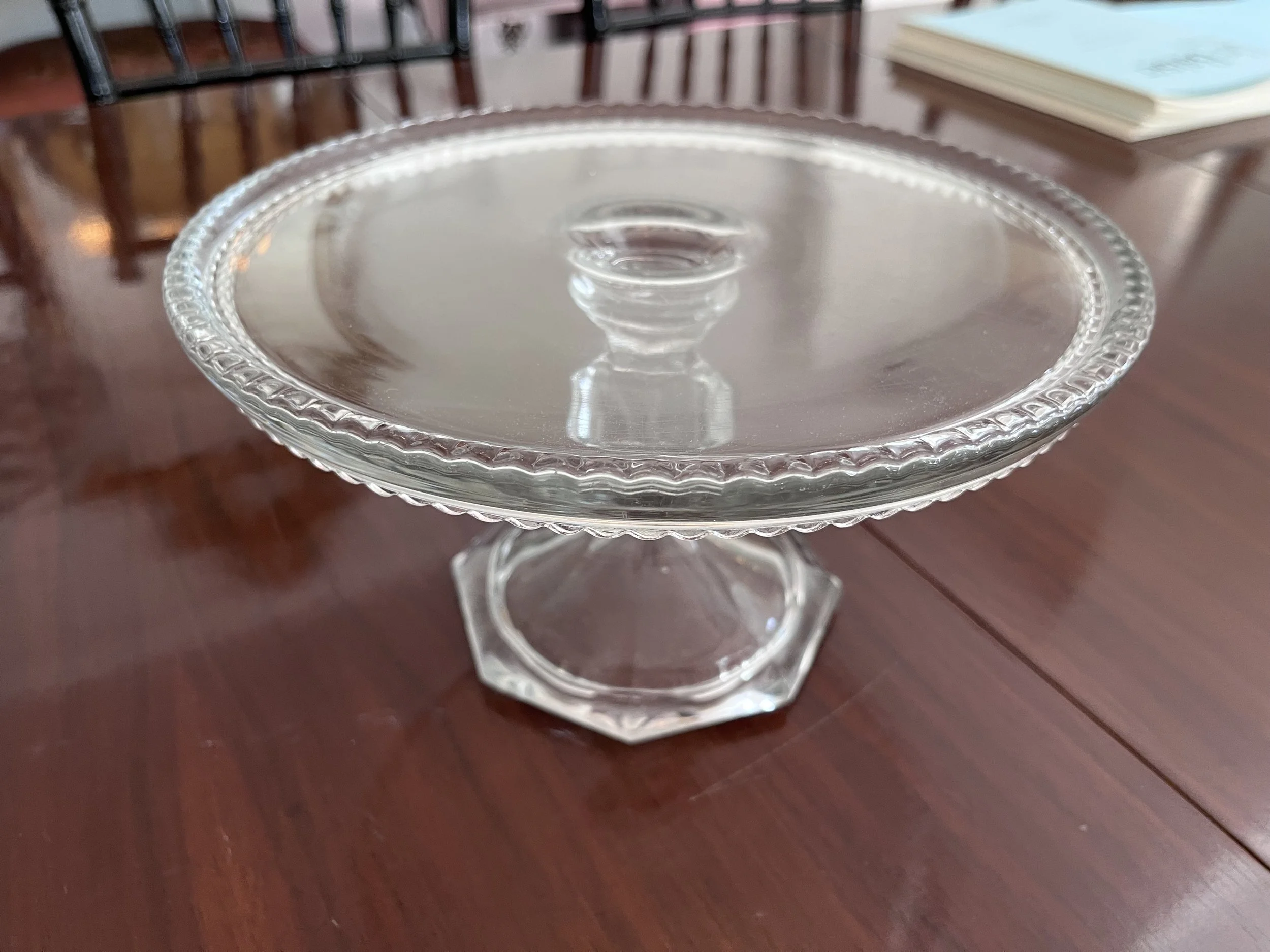

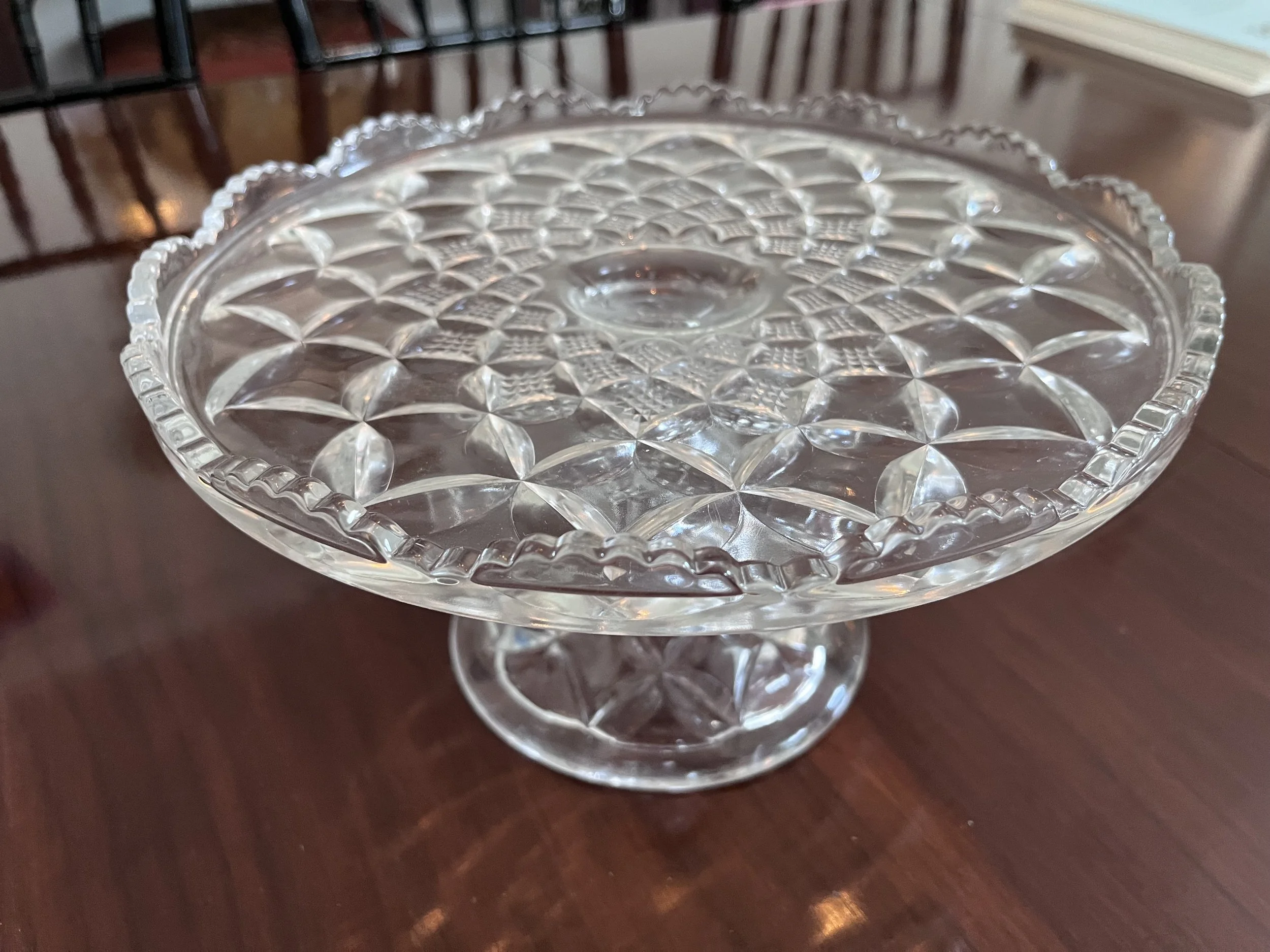
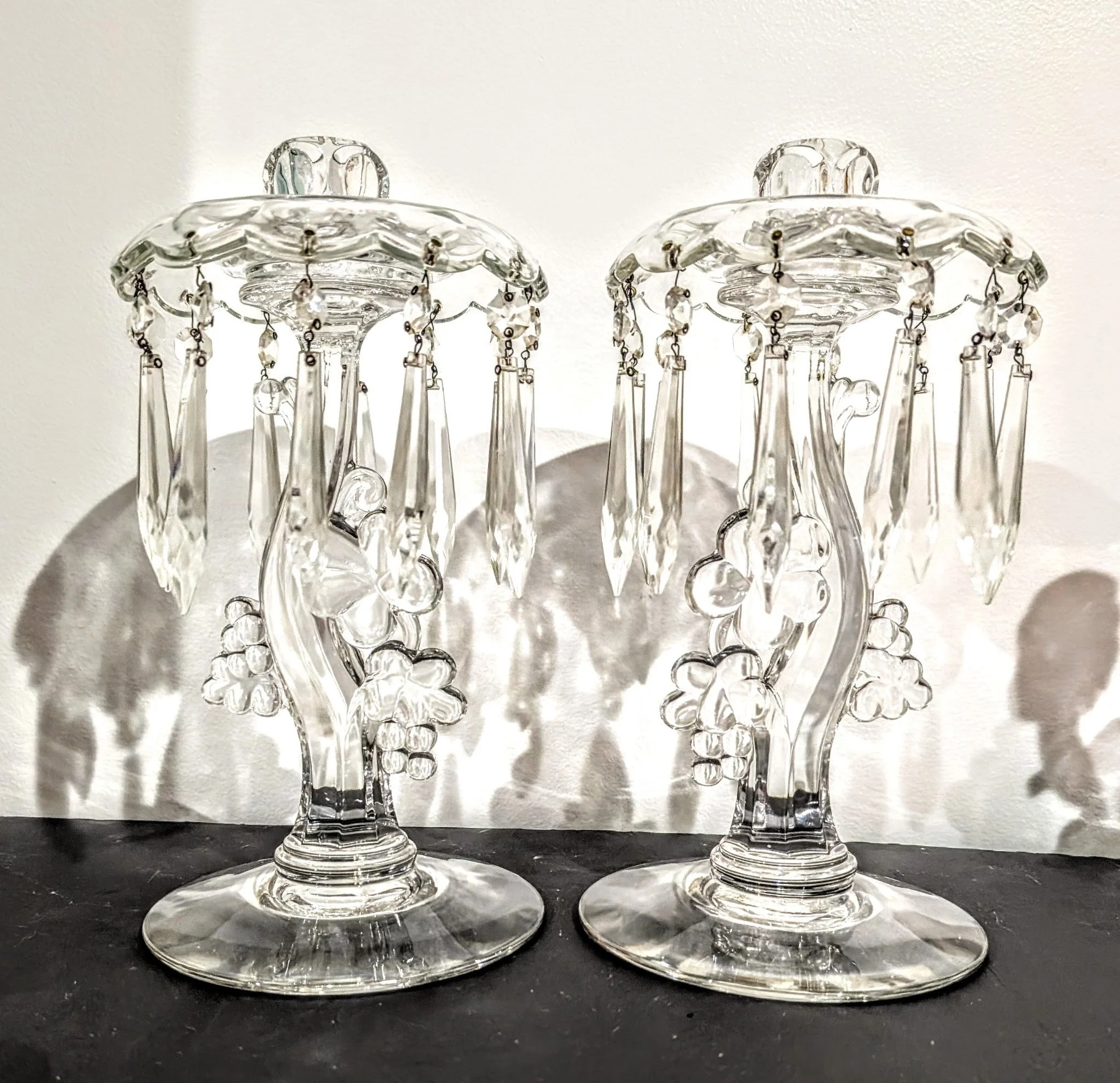
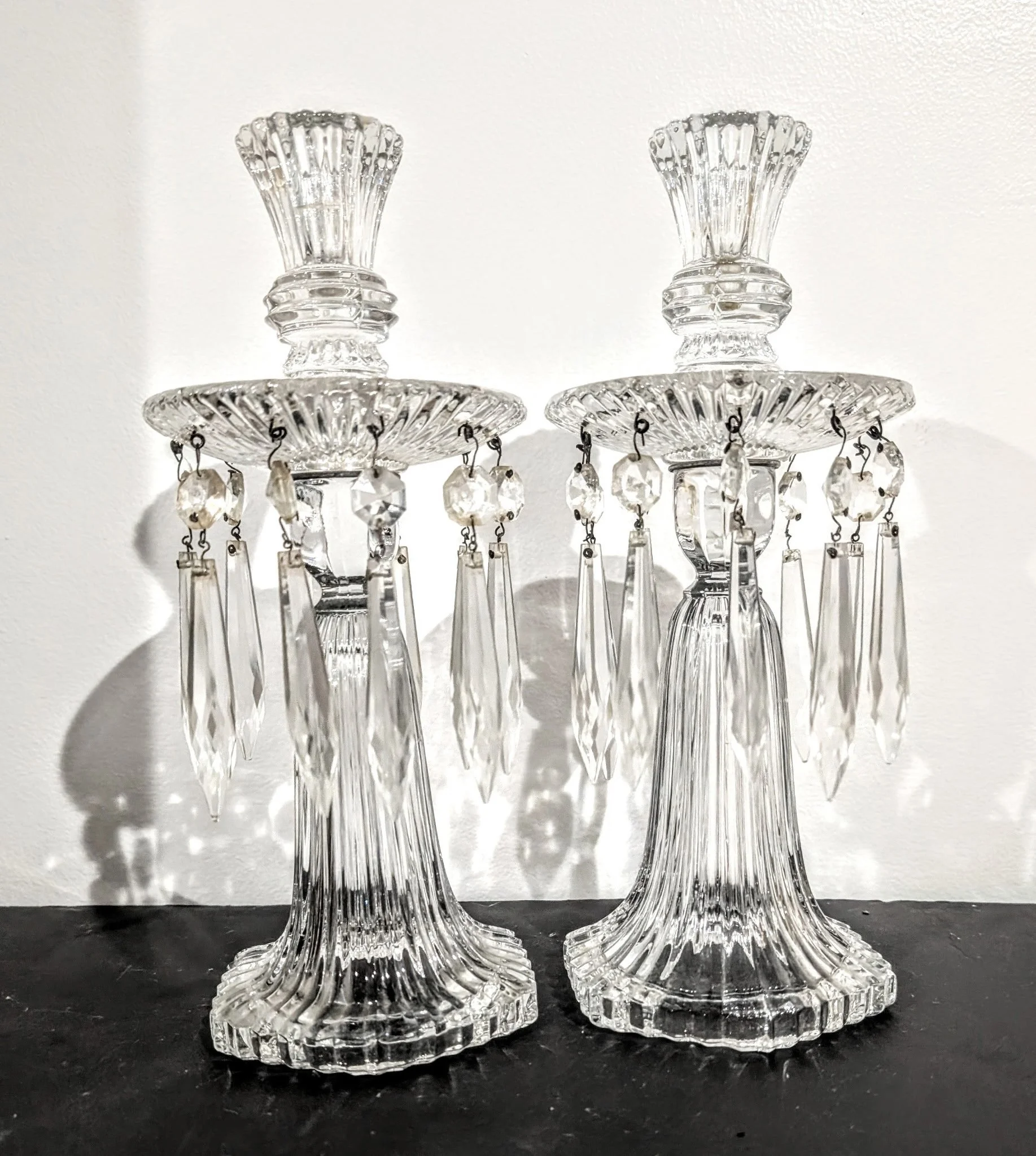
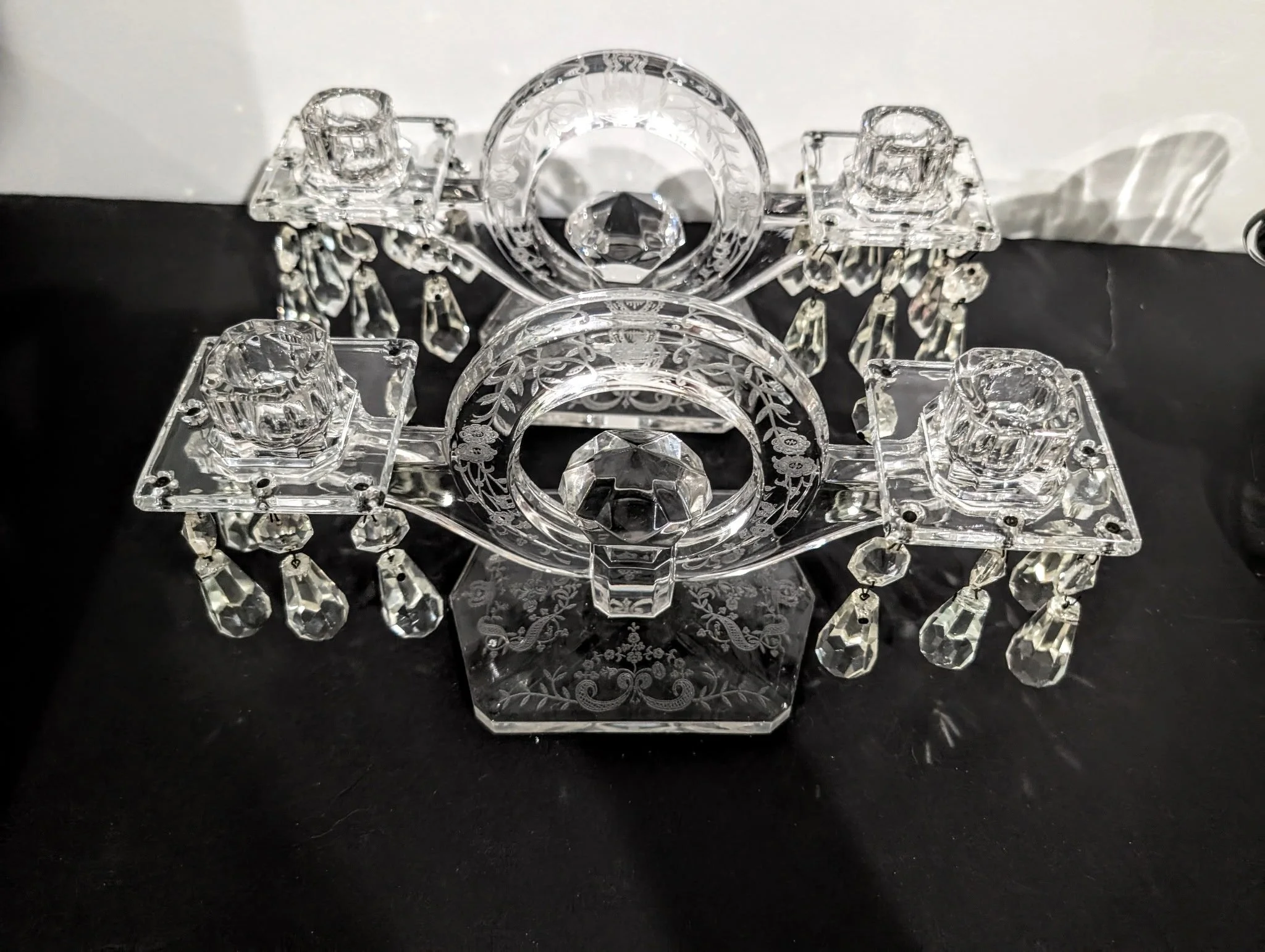
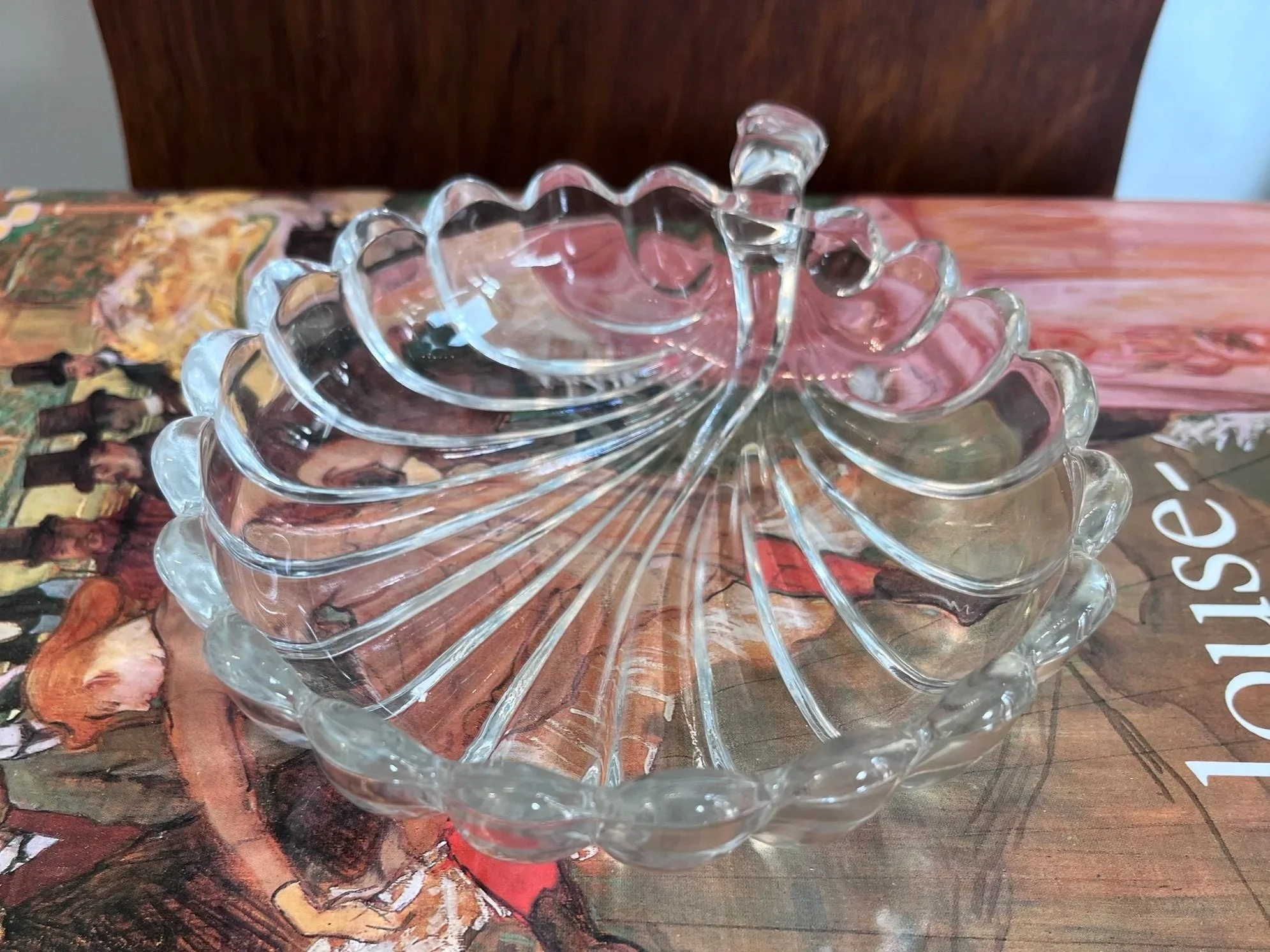

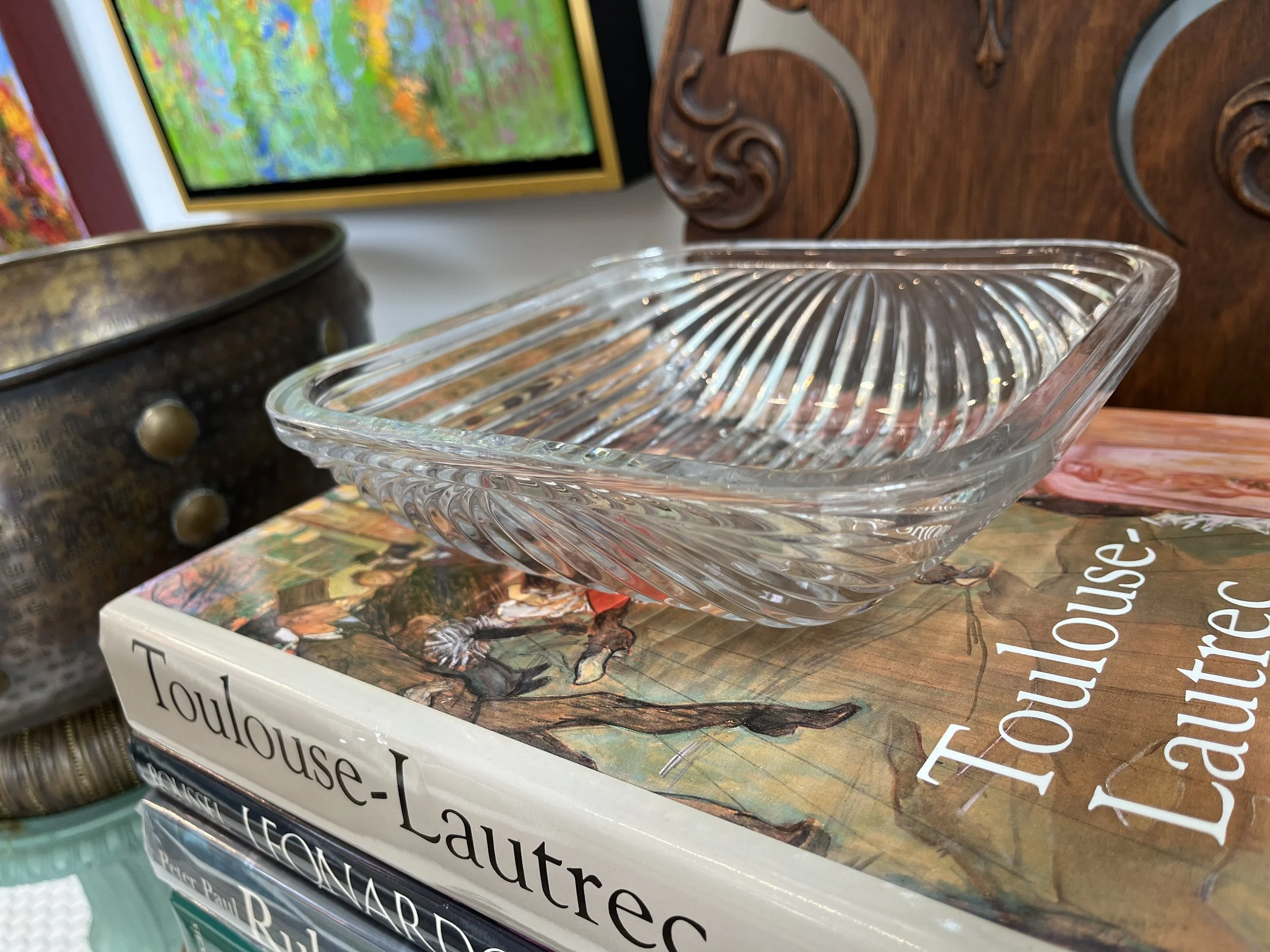
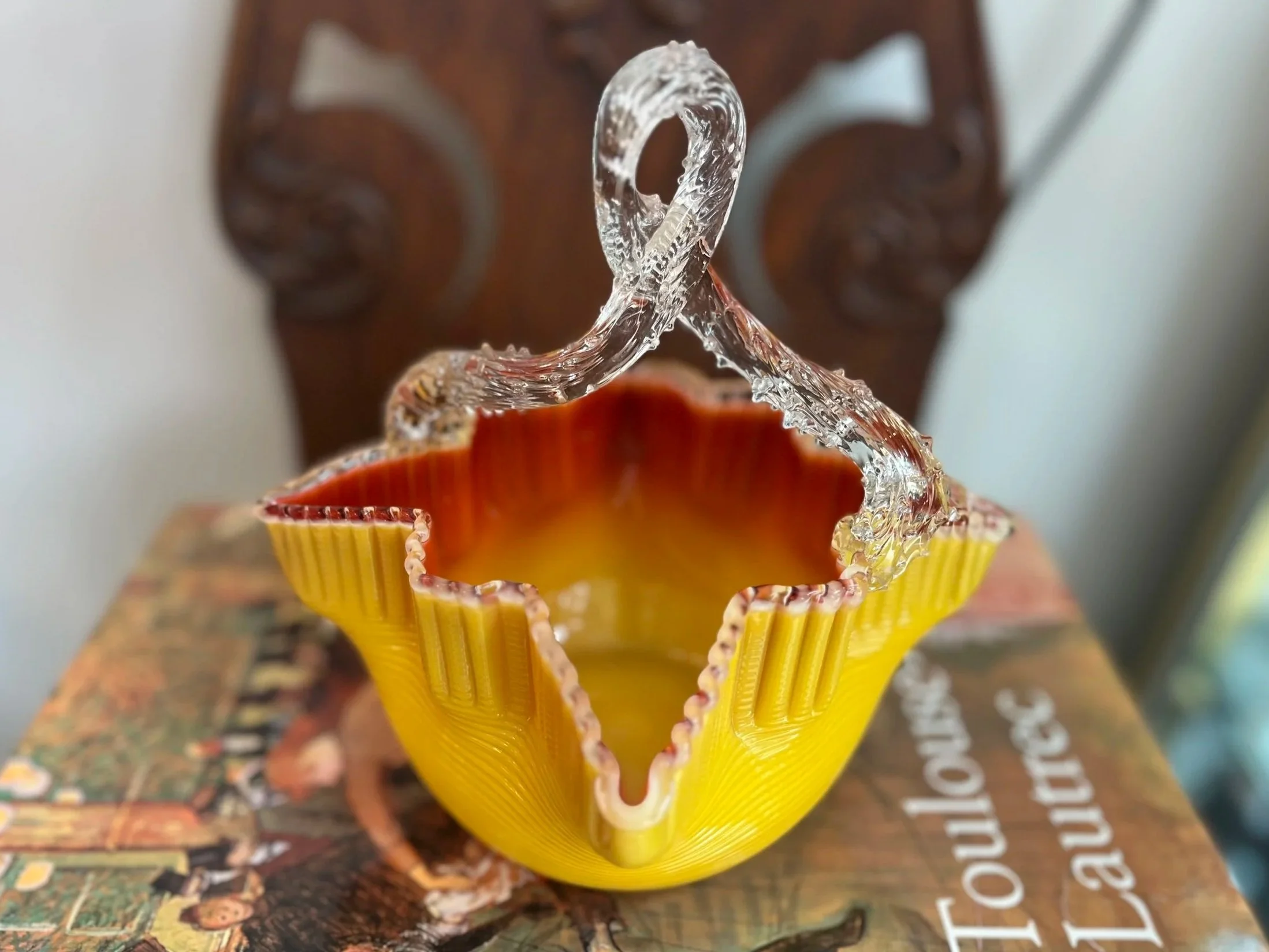
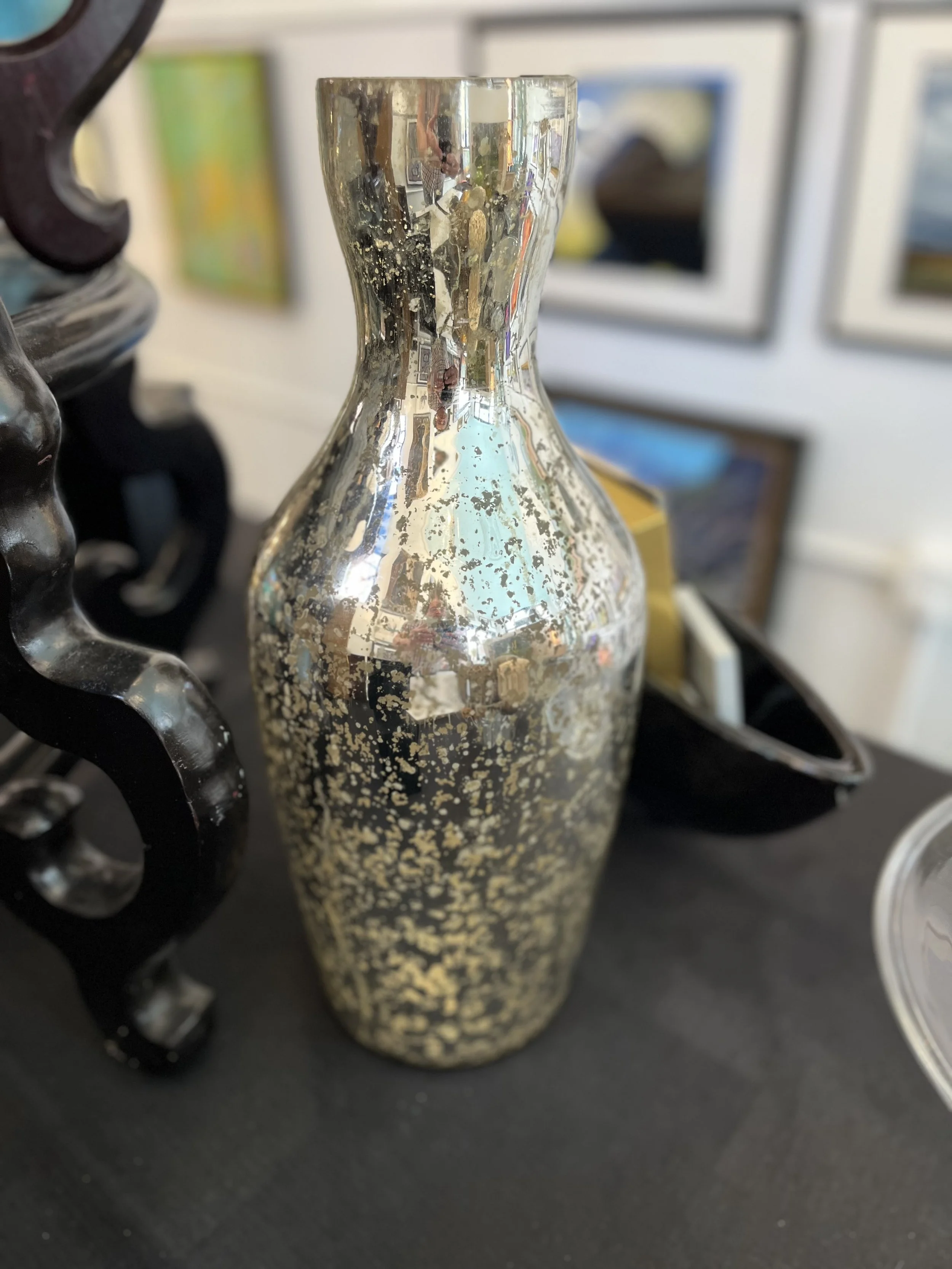




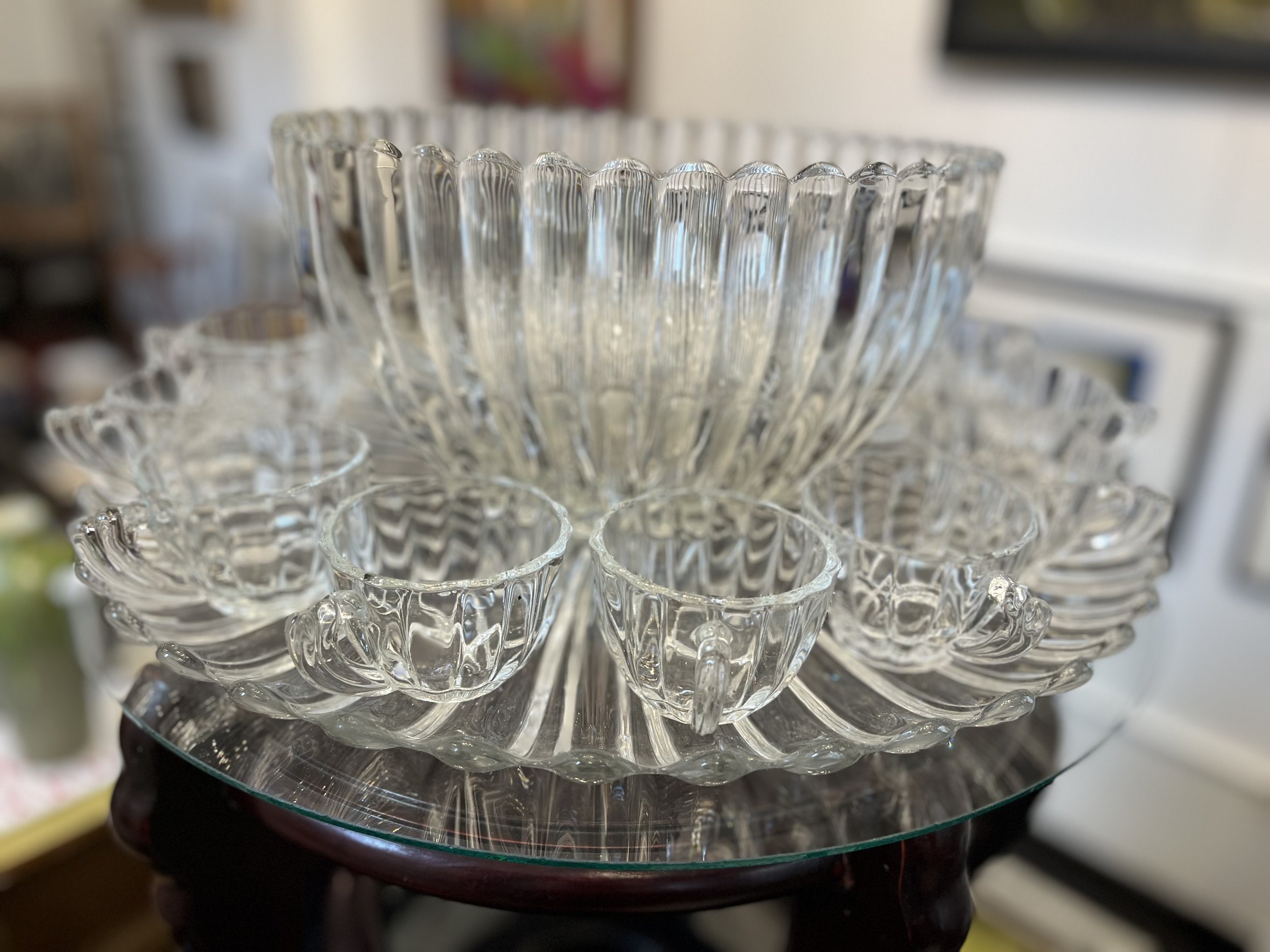





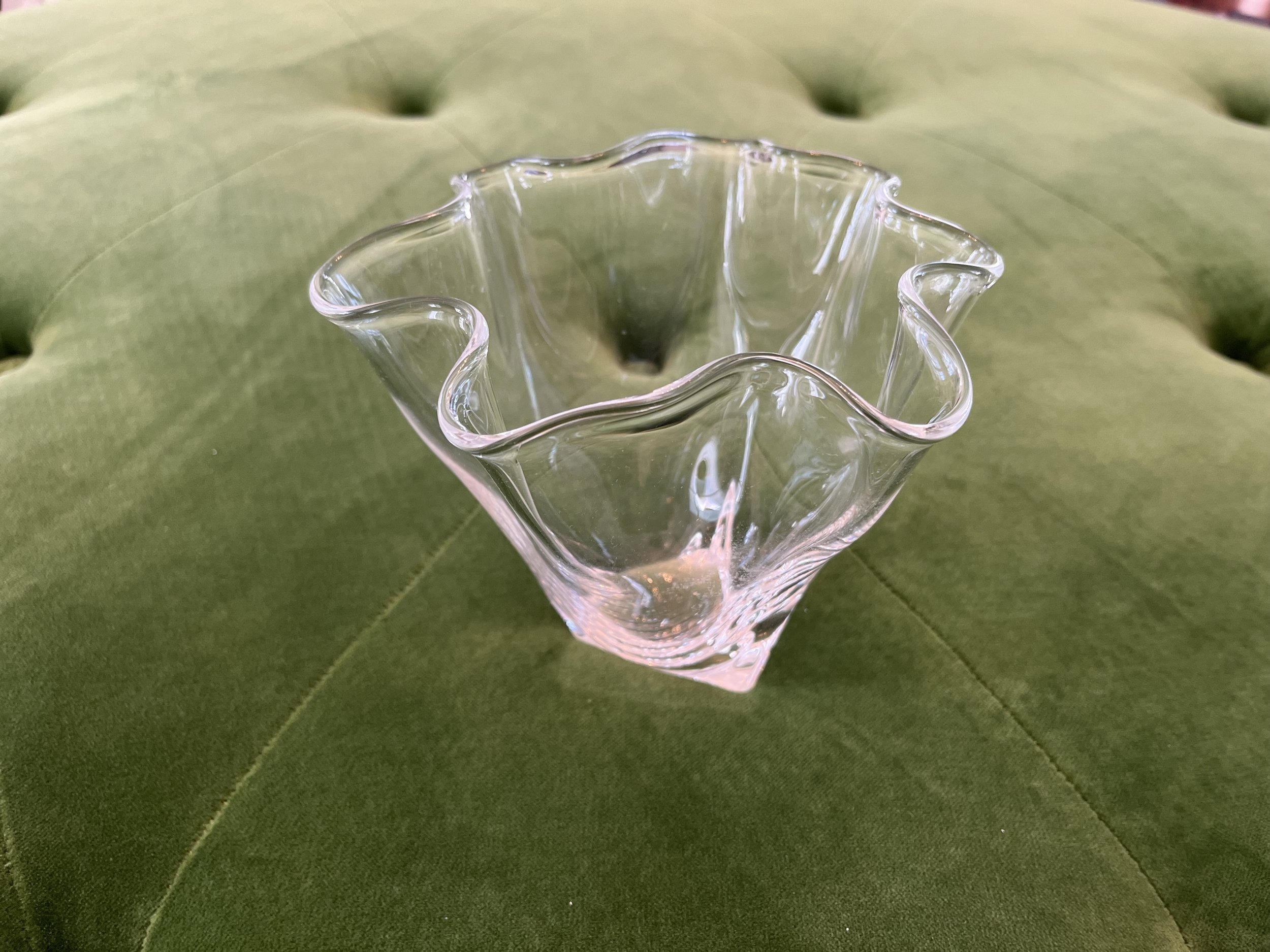


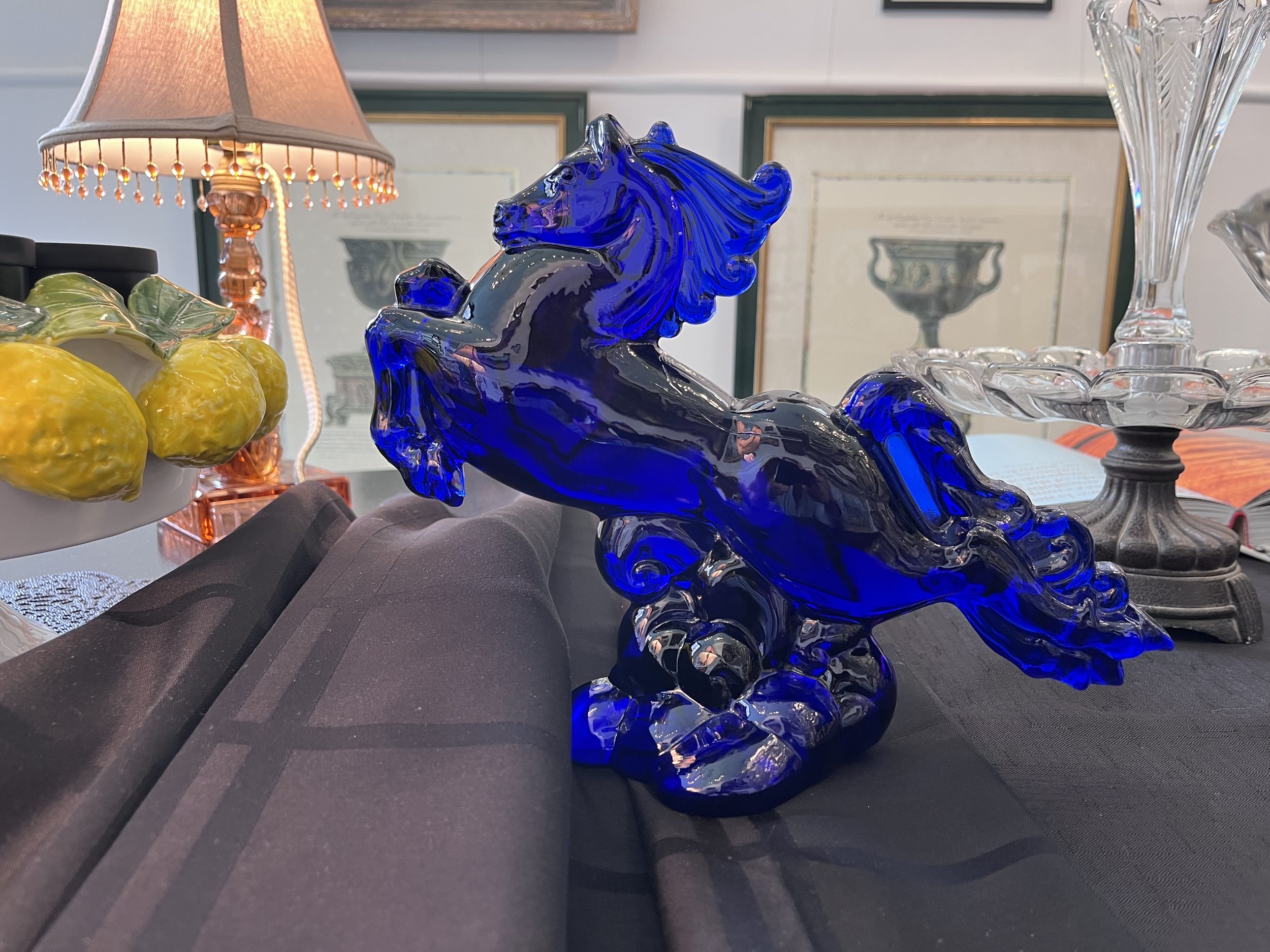
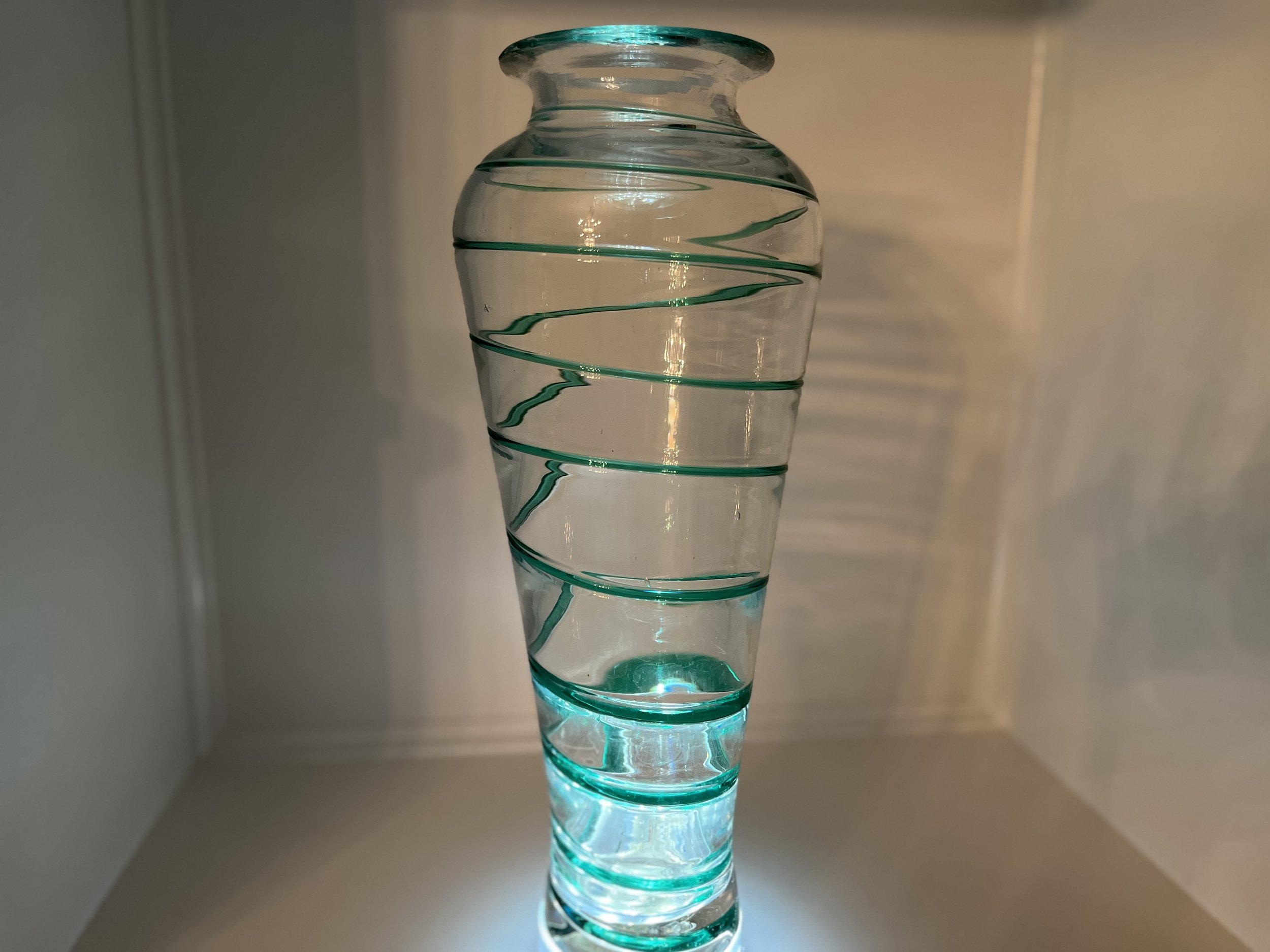
Turquoise Infinity Art Glass (6" x 5.5")
This is a modern decorative glass knot sculpture. The iridescent finish is acheived by applying metalic salts to the glass surface during the cooling process, creating a shimmering effect.
To inquire about pricing and availability, please email BALL HILL The Arcade at info@ballhill.com.